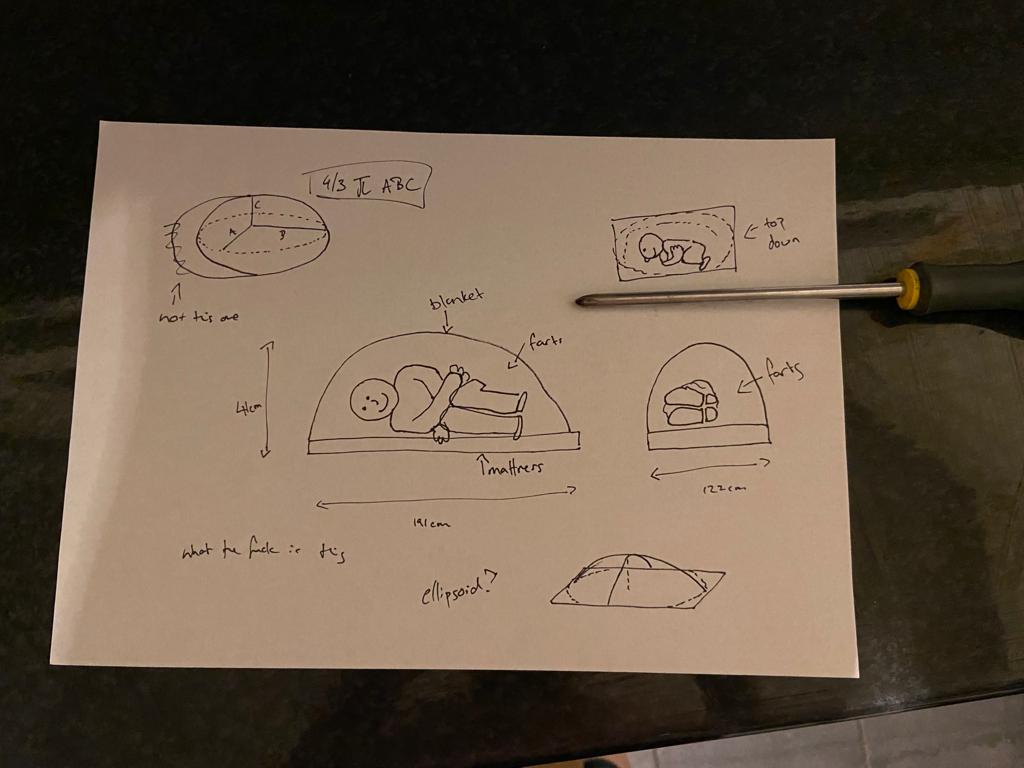Sometimes you wake up and do a great big fart, the kind that sounds like the world’s longest piece of paper being ripped.
But how much fart can you fart? Like, say you had a weighted blanket and curled up under it. Could you — with the right/wrong diet, the right angle and a bit of hard work — fart the whole blanket into the air? Could you inflate the whole thing from your butthole, so it floated above you like a smelly geodesic dome?
It’s a really appealing thought. Even if it only lasted a fleeting instant, for that brief moment you’d be in a stinky cavern of your own creation, an ephemeral malodorous cocoon. But believe it or not, the world of science hasn’t dived into this one yet.
Some numbers: Looking through mattress sizes, the smallest one where doming seems possible is a Super Single (which is also the state people who fart themselves into castles might find themselves in). That’s 48 inches wide and 75 inches long.
The position the farter lies in will determine how high the blanket has to go to clear them — lying on one’s front keeps the body nice and low, while curling into a ball feels like it will aid farting more, plus allows the blanket to be lower near the mattress edge. I’m going to go for a curled-up, fetal kind of a position for those reasons. The shoulders are the broadest part of the body, and one survey gives the average width as 16 inches, so that’s the clearance needed.
Now it’s time for some very flawed, physics-defying math. Going from a rectangular perimeter to a domed top is incredibly complicated, so I’m going to treat it like half of an ellipsoid — imagine the shape of a Tic-Tac sliced along the middle. The formula for the volume of an ellipsoid is 4/3 * π * A * B * C, where A, B and C are the semi-axes — half the width of the mattress, half the length of it and the whole of the curled-up stinker’s height, so a shoulder-to-shoulder measurement.

Omni Calculator’s ellipsoid calculation tool gives us 1,000,474 cubic centimeters, which we then half, resulting in the conclusion that we need 500,237 cubic centimeters of farted-out stink gas to fill the blanket (I’m going with the metric system here, because 1) I’m in the U.K.; and 2) that’s how the Omni Calculator spits out its answers and we’re already knee-deep in numbers).
Except, hold on, there’s a farter in there, farting the fart. The human body has around the same density as water — one gram per cubic centimeter. The average man (probably slightly more likely to attempt to fart themselves a smell-capsule than the average woman) weighs about 200 pounds, or 90,000 grams, which works out to the same amount of cubic centimeters in volume. Taking that off the figure, we’re left with 410,000 cubic centimetres to fill with ass.
That’s quite a lot. A 1991 paper in the medical journal Gut, titled “Investigation of Normal Flatus Production in Healthy Volunteers,” found a median fart production of 705 cubic centimeters every 24 hours. By that metric, it would take 582 days’ worth of farts — 19 months of it. That’s not going to happen. It doesn’t make any sense.
But two words in that title — “normal” and “healthy” — feel shiftable. What about abnormal flatus production in startlingly unhealthy volunteers? Conditions like celiac disease, Crohn’s disease, lactose intolerance and irritable bowel disease can all lead to excessive farting, while various foods — beans, lentils, cabbage, cauliflower, bok choy, fistfuls of bran — can make you fart like the world has gone entirely crazy. But even if you were so ill and had such a bad diet that you farted 50 times as much as a normal healthy person, you couldn’t fill a fart cavern.
The volume of a fart is limited by the volume of the intestines. Sometimes farts might feel enormous — Guinness, for instance, can lead to farts that feel like they could feed a family of four — but they really aren’t that big. There’s also the issue, if we’re treating this smelly semi-ellipsoid as airtight, of contravening the law of conservation of mass. However, as physicist and polymath Igor Ljubuncic points out, blankets aren’t airtight at all. “You can breathe through most blankets,” he says. “Plus, the fart would escape around the corners, so you’d need to tighten the borders or seal them to achieve the necessary lift.”
This might make it less of a fart-cavern and more of a fart-coffin, but in terms of sheer force, would lifting the blanket be doable? Weighted blankets start at around 11 pounds. Ljubuncic has dug into the physics of farts before, and using a few approximations — e.g., the dimensions of a dime to represent the anus — concluded that farting your whole body into the air would be possible, but only if your intestines were fortified to the point that they could withstand pressure equal to that found seven miles beneath the sea. (This is almost exactly the depth of the Mariana Trench. Proof of God’s plans, perhaps.) A blanket weighs less than a body, but would still require extraordinarily fortified bowels.
But leaving the dome part aside, could you lift the weight? Like, if the weighted blanket was compressed in the style of a promotional T-shirt? To answer that, it’s best to look to the animal kingdom.
Interestingly, penguins release farts and poops at much higher pressure than humans. (“Interestingly.”) A 2003 paper in Polar Biology, “Pressures Produced When Penguins Pooh — Calculations on Avian Defaecation” (which admittedly deals with shitting rather than farting), found penguins can generate pressure of 60 kilopascals when expelling oily dumps. One kilopascal is equal to the pressure of a 10-gram mass on one square centimeter of area (the metric system again!). So if a penguin had a very light blanket compressed to the width of a pencil, and also had IBS and an all bok-choy diet, and everything was positioned perfectly, then yes, the blanket would at least move when farted at.
Ljubuncic is philosophical about the whole endeavor. “You can lift things, definitely,” he says, explaining it all just comes down to how small you’re willing to go when defining movement. “Moving an object by one millimeter? One micrometer? One nanometer? You can. It might not be visible to the naked eye, but the laws of physics tell us it will happen.”
And that’s something. It’s not a true fart cocoon, the dream of which will continue to elude humanity until some glorious future date when bowel developments lurch forward. But it’s something.

